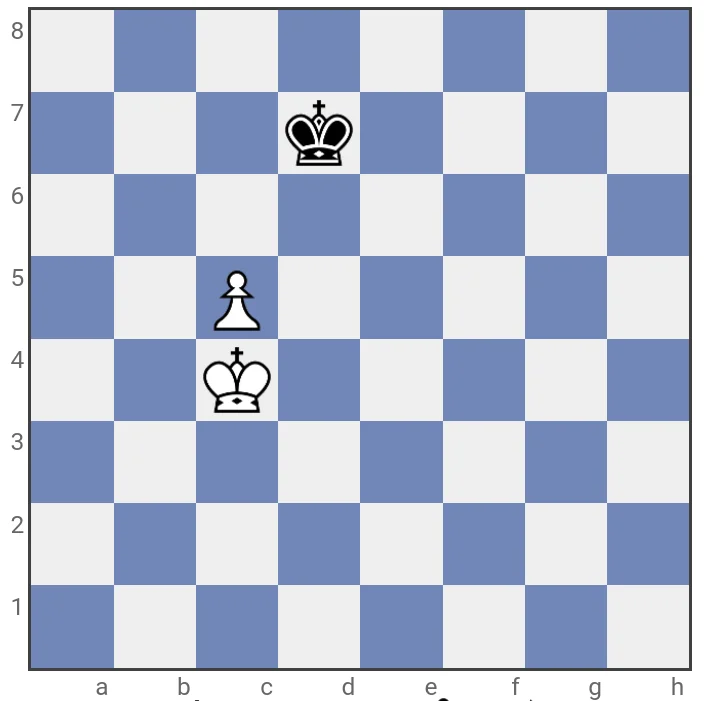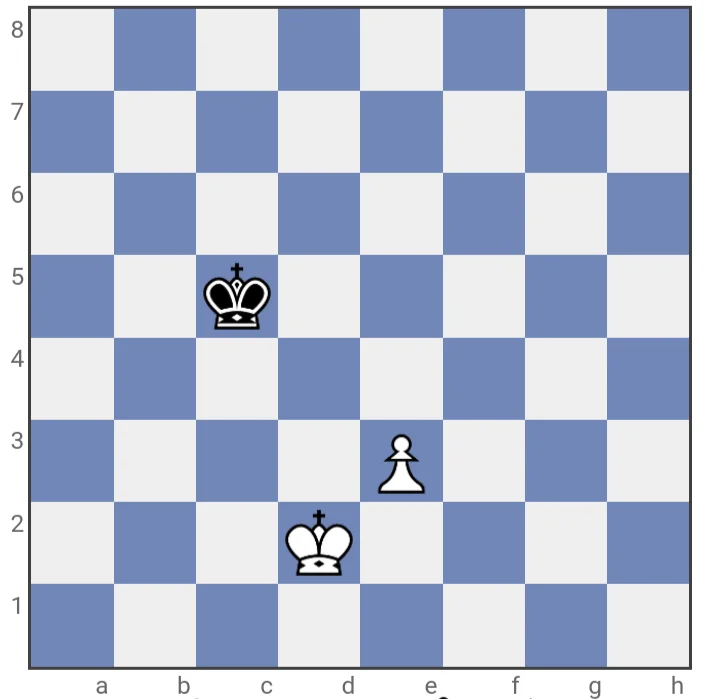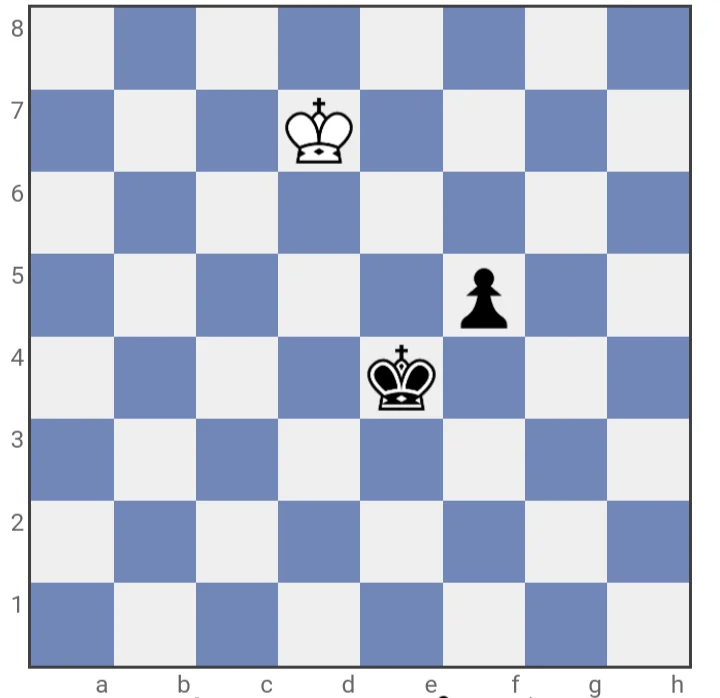In the exciting journey through the world of chess, we’ve already embarked on quite the adventure. From learning the very basics of how to play chess for beginners to delving into the intricate realm of opening strategy the concept of space, we’ve honed our skills and sharpened our wits on the 64 squares of the chessboard. But now, it’s time to explore a realm that holds the essence of chess mastery–endgame strategy.
As you progress in your chess journey, you’ll find that the endgame is where true mastery is often achieved. In the endgame, the battlefield is stripped down, with fewer pieces and an intense focus on technique and precision. And in this blog post, we’re going to unravel one of the most captivating endgame scenarios: the battle of “Two Kings, One Pawn, One Winner.”
That’s right, we’ll be delving into the art of checkmating your opponent when it’s just your King and a single Pawn versus their lone king. It’s a scenario that might appear deceptively simple, yet it conceals a treasure trove of tactics, subtleties, and strategies that can decide the fate of the game.
If you’re ready to elevate your chess skills to the next level and discover the secrets of triumphing with precision, read on.
The Essence of the Endgame
The endgame is the final phase of a chess game, where the board becomes less crowded, and strategic maneuvering takes center stage. It’s in this stage that your ability to convert a material advantage, such as having an extra pawn, into victory truly shines.
Understanding the Scenario
In our featured scenario, you are left with your King and a single pawn, while your opponent has only their King remaining. While it might seem like a straightforward situation, it’s rife with complexities. Winning here requires careful planning, precise technique, and an understanding of key principles.
Key Principles
1. King Activity: Your King should be actively centralized to support the pawn’s advance. Centralization ensures your King’s proximity to both sides of the board and allows it to assist in Pawn promotion.
2. Pawn Promotion: The ultimate goal is to promote your Pawn into a Queen or another powerful piece. This can be achieved by advancing your Pawn while ensuring it receives proper support from your king.
3. Opposition: Understanding opposition is crucial to controlling key squares and advancing your king. Opposition involves placing your King directly in front of your opponent’s king, forcing them to yield ground and create pathways for your pawn.
Tactics and Techniques
Winning the “Two Kings, One Pawn, One Winner” endgame involves employing specific tactics and techniques:
The Square of the Pawn
The square of the Pawn is a vital concept. It’s the area consisting of the square formed by your pawn’s current position and the four squares directly in front, to the sides, and behind it. Your King should aim to enter this square to support your pawn’s advance while restricting the opposing King’s movement.
The Key Squares
Identifying and controlling key squares is essential. These are the squares your Pawn must reach to promote successfully. Knowing how to escort your Pawn to these squares while maintaining opposition is a hallmark of endgame expertise.
Zugzwang
Zugzwang, a German term for “compulsion to move,” plays a crucial role in this endgame. It’s a situation where any move you make puts your opponent at a disadvantage. By recognizing zugzwang positions, you can manipulate your opponent into maKing unfavorable moves, leading to victory.
Practice and Mastery
As with any aspect of chess, practice is essential. Here are some practical exercises to help you master the “Two Kings, One Pawn, One Winner” endgame:
Exercise 1: Pawn Promotion
Set up a board with your King and Pawn against your opponent’s king. Practice advancing your Pawn and promoting it into a Queen while ensuring your King maintains control of the square of the pawn.
Exercise 2: Opposition Drills
Work on recognizing and achieving opposition. Set up positions where your goal is to place your King in front of your opponent’s king, gradually pushing them back and creating pathways for your pawn.
Exercise 3: Zugzwang Scenarios
Create positions where you force your opponent into zugzwang. Practice maKing moves that put them in a position where any move they make weakens their position or allows you to advance your pawn.
The endgame is where many games are won or drawn, so mastering it is a significant step toward becoming a formidable chess player.
Practice Exercises: Mastering Two Kings, One Pawn, One Winner
To truly grasp the intricacies of the “Two Kings, One Pawn, One Winner” endgame scenario, practice is key. Let’s dive into some practical exercises that will help you sharpen your skills and elevate your endgame prowess.
Exercise 1: Pawn Promotion
Objective: Promote your Pawn into a Queen while ensuring your King provides support.
Set up the following position on your chessboard:

With your King and Pawn against your opponent’s King, your task is to advance your Pawn and promote it into a Queen. Pay close attention to maintaining control of the square of the Pawn throughout the exercise. Practice this scenario multiple times to hone your Pawn promotion skills.
Exercise 2: Opposition Drills
Objective: Recognize and achieve opposition to create pathways for your pawn.
Set up the following position on your chessboard:

Your goal in this exercise is to master the art of opposition. Place your King in front of your opponent’s King and gradually push them back, creating pathways for your Pawn to advance. Practice different opposition scenarios to become proficient in controlling key squares.
Exercise 3: Zugzwang Scenarios
Objective: Manipulate your opponent into zugzwang positions.
Create positions like the one shown below on your chessboard:

Here, your aim as Black is to force your opponent into zugzwang. Make moves that put them in a position where any move they make weakens their position or allows you to advance your Pawn. Recognizing zugzwang scenarios is a valuable skill in this endgame.
Tips for Practicing Distant Opposition in Chess Endgames
- Set Up the Position: Start by setting up the specific endgame scenario on a chessboard. You’ll need your King and Pawn against your opponent’s King with the pawn ready for promotion. Familiarize yourself with the starting position to better understand the dynamics of distant opposition.
- Practice With Both Colors: True mastery of distant opposition comes from practicing it from both sides. Play as the side with the King and pawn and as the side with just the King. This dual perspective will help you anticipate your opponent’s moves and challenges.
- Use Online Chess Platforms: Take advantage of online chess platforms that offer practice puzzles and drills for endgames. Seek out puzzles specifically focused on distant opposition, and regularly engage with these exercises to refine your skills.
- Study Grandmaster Games: Immerse yourself in games played by grandmasters in King and Pawn versus King endgames. Pay close attention to their King positioning, maneuvers, and how they skillfully utilize distant opposition to secure a win. Such analysis can inspire your own strategies.
- Practice Regularly: Consistency is key to mastering distant opposition. Dedicate specific practice sessions to endgames, focusing on maintaining distant opposition effectively. Repetition helps reinforce your understanding and improve your technique.
- Seek Guidance: If possible, seek guidance from a chess coach or an experienced player. They can provide personalized instruction, offer valuable insights, and help you refine your distant opposition skills through one-on-one practice.
Conclusion
The world of chess is as vast as it is captivating, and the endgame is its heart and soul. You’ve now gained valuable insights into the intricate strategies of the “Two Kings, One Pawn, One Winner” endgame. It’s a scenario that demands precision, calculation, and a deep understanding of these key principles.
Stay tuned for our upcoming posts, where we’ll continue to explore the world of chess, unraveling more endgame tactics, strategies, and tips.